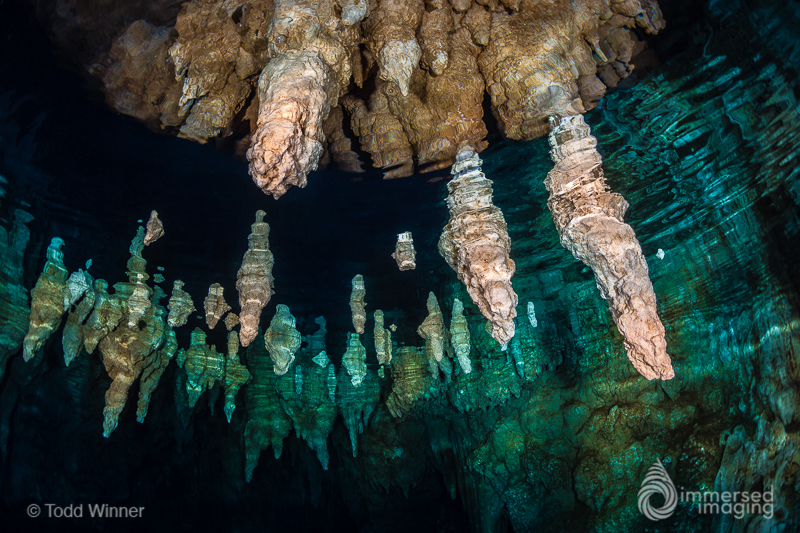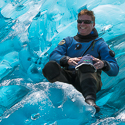 Nauticam Housing
Nauticam Housing,
Ikelite DS160 strobes,
Canon 5D Mark III,
Canon EF 8-15mm Fisheye Lens @8mm 1/80, f/8.0 ISO 160
Underwater photography offers us so many unique opportunities that land photographers never get to experience. Just being neutrally buoyant allows us to position ourselves for shots that would be impossible on land. Light behaves quite differently underwater as well, and one of the best places to see some of these effects is near the surface. Reflections can add another interesting element to our images and with smooth flat surfaces you can create almost perfectly mirrored images.

Canon 5D Mark III, EF 8-15mm Fisheye @15mm 1/160, f/11 ISO1600
Location
Chandelier Cave in Palau is a truly amazing place that offers the average recreational diver a brief look at what usually only cave divers get to see. Although Chandelier is technically a true cave, the interior has four large air chambers that allow divers to ascend, making it very safe for most. Once inside, divers are greeted by hundreds of stalactites hanging from the ceiling. These were created millions of years ago when the cave was above water. Many of the stalactites extend into the water and they seem to come in an endless variety of colors. One of the largest formations is in the first chamber and shimmers as you shine your light on its surface. It's no wonder the cave was named Chandelier.

Canon 5D Mark III, EF 8-15mm Fisheye @15mm 1/80, f/8.0 ISO 160
The Reflection
Although you can see ambient light from the cave opening during the day, there is no ambient light inside the cave to help with focusing. You will need a focusing light or use the modeling lights on your strobes. Since there is no ambient light inside, our shutter speed does not really matter and auto modes are not going to know what to do in total darkness so set your camera exposure to manual. Set an aperture that is going to give you a lot of depth of field. I would start at around
f/8 to
f/11 on most wide-angle lenses. ISO can be set fairly low as long as you have powerful enough strobes to cover the area you would like to light. I would suggest an ISO around 200 to 400. As mentioned earlier shutter speed does not really matter as long as no one shines a light into your camera or onto your subject. I would start at around 1/100th to 1/200th of a sec. You can use TTL, but once you have your aperture set, it is very easy to adjust either your strobe power settings or your distance from the subject to achieve the proper exposure. To capture the reflection, get close to the surface and angle the camera until you see the reflection in the viewfinder. This happens at a camera angle of 42 degrees or less from the surface. The calmer the water, the more the reflection will look like a mirror.

Canon 5D Mark III, EF 8-15mm Fisheye @15mm 1/125, f/7.1 ISO 160
Post Processing
I really wanted the detail and colors to pop on these images. In
Lightroom, I balanced out the exposure, opening up the shadow so I could see more detail at the back of the cave and pulling down the highlights to keep detail on the foreground stalactites. Next, I added some clarity, which adds some overall sharpening and helps define all the little details in the rock. I also added vibrance to bring out the colors. Chandelier Cave is an incredible dive site for photographers. The possibilities are almost endless! You don't have to wait until you are in Palau to shoot reflections, but Chandelier Cave is just full of opportunities if you happen to be there.
 Nauticam Housing, Ikelite DS160 strobes, Canon 5D Mark III, Canon EF 8-15mm Fisheye Lens @8mm 1/80, f/8.0 ISO 160
Underwater photography offers us so many unique opportunities that land photographers never get to experience. Just being neutrally buoyant allows us to position ourselves for shots that would be impossible on land. Light behaves quite differently underwater as well, and one of the best places to see some of these effects is near the surface. Reflections can add another interesting element to our images and with smooth flat surfaces you can create almost perfectly mirrored images.
Nauticam Housing, Ikelite DS160 strobes, Canon 5D Mark III, Canon EF 8-15mm Fisheye Lens @8mm 1/80, f/8.0 ISO 160
Underwater photography offers us so many unique opportunities that land photographers never get to experience. Just being neutrally buoyant allows us to position ourselves for shots that would be impossible on land. Light behaves quite differently underwater as well, and one of the best places to see some of these effects is near the surface. Reflections can add another interesting element to our images and with smooth flat surfaces you can create almost perfectly mirrored images.
 Canon 5D Mark III, EF 8-15mm Fisheye @15mm 1/160, f/11 ISO1600
Location
Chandelier Cave in Palau is a truly amazing place that offers the average recreational diver a brief look at what usually only cave divers get to see. Although Chandelier is technically a true cave, the interior has four large air chambers that allow divers to ascend, making it very safe for most. Once inside, divers are greeted by hundreds of stalactites hanging from the ceiling. These were created millions of years ago when the cave was above water. Many of the stalactites extend into the water and they seem to come in an endless variety of colors. One of the largest formations is in the first chamber and shimmers as you shine your light on its surface. It's no wonder the cave was named Chandelier.
Canon 5D Mark III, EF 8-15mm Fisheye @15mm 1/160, f/11 ISO1600
Location
Chandelier Cave in Palau is a truly amazing place that offers the average recreational diver a brief look at what usually only cave divers get to see. Although Chandelier is technically a true cave, the interior has four large air chambers that allow divers to ascend, making it very safe for most. Once inside, divers are greeted by hundreds of stalactites hanging from the ceiling. These were created millions of years ago when the cave was above water. Many of the stalactites extend into the water and they seem to come in an endless variety of colors. One of the largest formations is in the first chamber and shimmers as you shine your light on its surface. It's no wonder the cave was named Chandelier.
 Canon 5D Mark III, EF 8-15mm Fisheye @15mm 1/80, f/8.0 ISO 160
The Reflection
Although you can see ambient light from the cave opening during the day, there is no ambient light inside the cave to help with focusing. You will need a focusing light or use the modeling lights on your strobes. Since there is no ambient light inside, our shutter speed does not really matter and auto modes are not going to know what to do in total darkness so set your camera exposure to manual. Set an aperture that is going to give you a lot of depth of field. I would start at around f/8 to f/11 on most wide-angle lenses. ISO can be set fairly low as long as you have powerful enough strobes to cover the area you would like to light. I would suggest an ISO around 200 to 400. As mentioned earlier shutter speed does not really matter as long as no one shines a light into your camera or onto your subject. I would start at around 1/100th to 1/200th of a sec. You can use TTL, but once you have your aperture set, it is very easy to adjust either your strobe power settings or your distance from the subject to achieve the proper exposure. To capture the reflection, get close to the surface and angle the camera until you see the reflection in the viewfinder. This happens at a camera angle of 42 degrees or less from the surface. The calmer the water, the more the reflection will look like a mirror.
Canon 5D Mark III, EF 8-15mm Fisheye @15mm 1/80, f/8.0 ISO 160
The Reflection
Although you can see ambient light from the cave opening during the day, there is no ambient light inside the cave to help with focusing. You will need a focusing light or use the modeling lights on your strobes. Since there is no ambient light inside, our shutter speed does not really matter and auto modes are not going to know what to do in total darkness so set your camera exposure to manual. Set an aperture that is going to give you a lot of depth of field. I would start at around f/8 to f/11 on most wide-angle lenses. ISO can be set fairly low as long as you have powerful enough strobes to cover the area you would like to light. I would suggest an ISO around 200 to 400. As mentioned earlier shutter speed does not really matter as long as no one shines a light into your camera or onto your subject. I would start at around 1/100th to 1/200th of a sec. You can use TTL, but once you have your aperture set, it is very easy to adjust either your strobe power settings or your distance from the subject to achieve the proper exposure. To capture the reflection, get close to the surface and angle the camera until you see the reflection in the viewfinder. This happens at a camera angle of 42 degrees or less from the surface. The calmer the water, the more the reflection will look like a mirror.
 Canon 5D Mark III, EF 8-15mm Fisheye @15mm 1/125, f/7.1 ISO 160
Post Processing
I really wanted the detail and colors to pop on these images. In Lightroom, I balanced out the exposure, opening up the shadow so I could see more detail at the back of the cave and pulling down the highlights to keep detail on the foreground stalactites. Next, I added some clarity, which adds some overall sharpening and helps define all the little details in the rock. I also added vibrance to bring out the colors. Chandelier Cave is an incredible dive site for photographers. The possibilities are almost endless! You don't have to wait until you are in Palau to shoot reflections, but Chandelier Cave is just full of opportunities if you happen to be there.
Canon 5D Mark III, EF 8-15mm Fisheye @15mm 1/125, f/7.1 ISO 160
Post Processing
I really wanted the detail and colors to pop on these images. In Lightroom, I balanced out the exposure, opening up the shadow so I could see more detail at the back of the cave and pulling down the highlights to keep detail on the foreground stalactites. Next, I added some clarity, which adds some overall sharpening and helps define all the little details in the rock. I also added vibrance to bring out the colors. Chandelier Cave is an incredible dive site for photographers. The possibilities are almost endless! You don't have to wait until you are in Palau to shoot reflections, but Chandelier Cave is just full of opportunities if you happen to be there.






